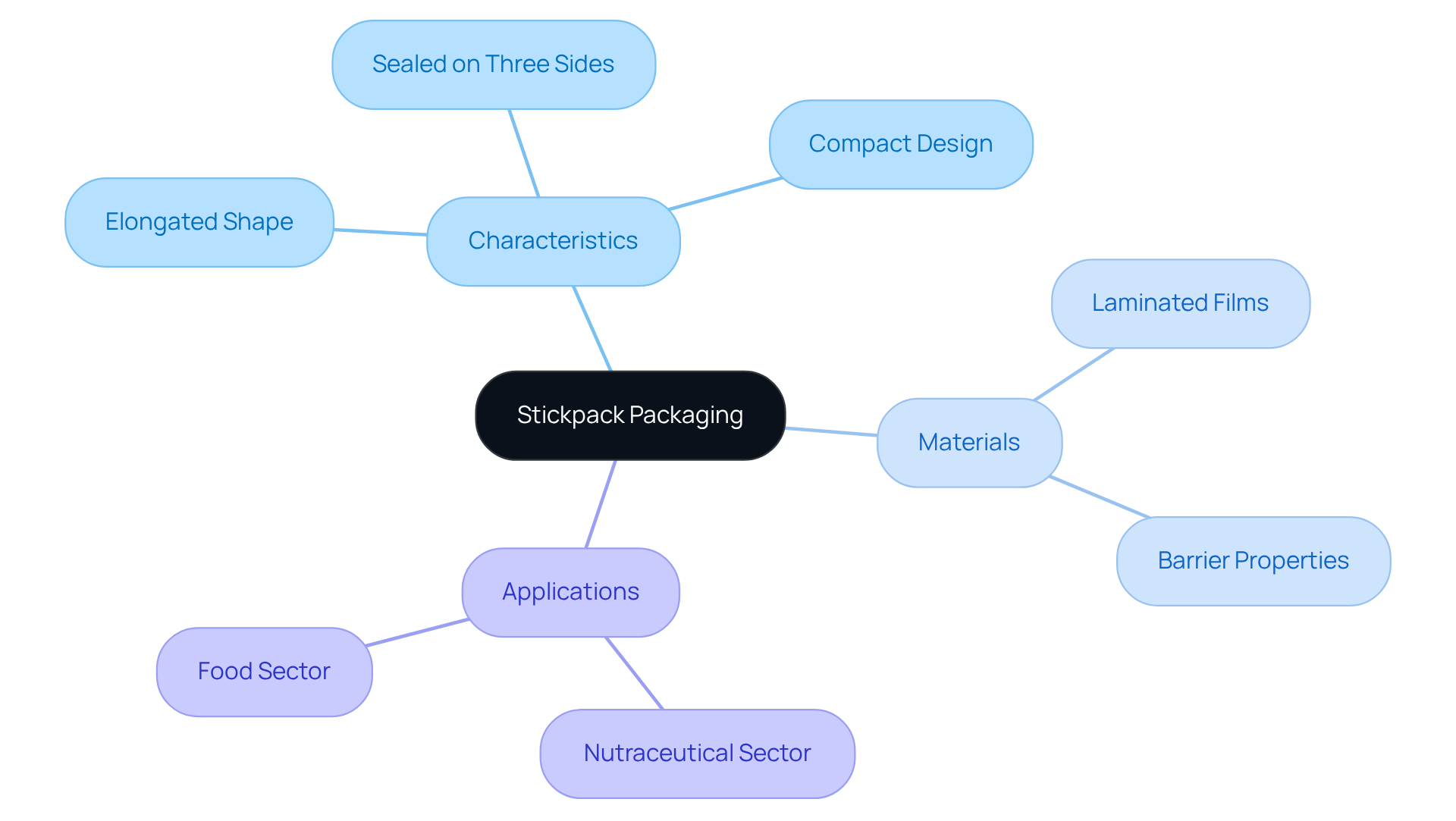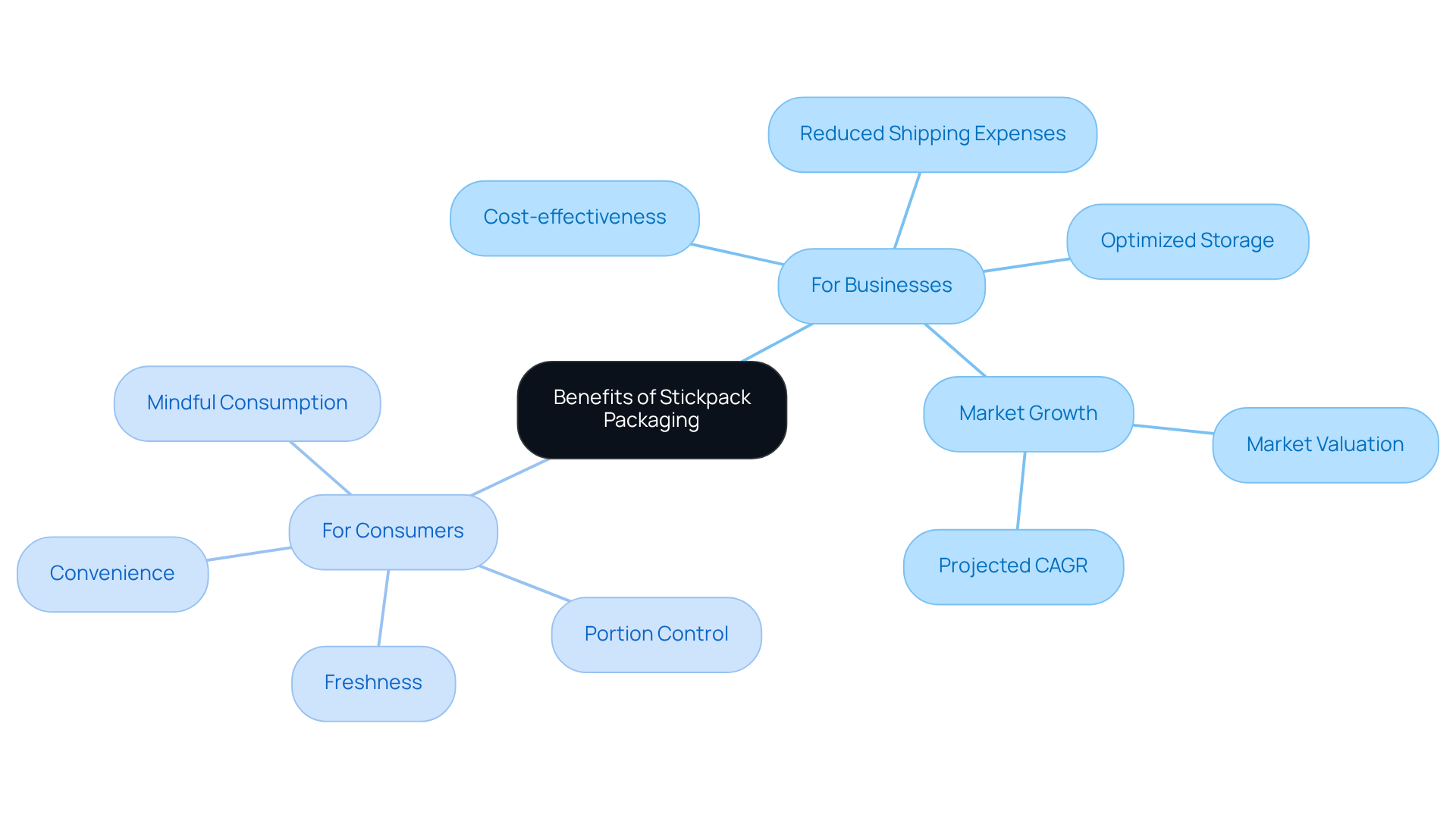Overview
Stickpack packaging is defined by its elongated, tubular design that facilitates single-serve portions, delivering substantial benefits such as convenience, cost-effectiveness, and enhanced product freshness. This innovative packaging format is increasingly gaining traction across various sectors, including food, nutraceuticals, and pharmaceuticals. Its ability to meet modern consumer demands for portability and portion control, while simultaneously reducing production and shipping costs for businesses, underscores its value.
As the market evolves, adopting stickpack packaging not only aligns with consumer preferences but also positions companies for greater efficiency and competitiveness.
Introduction
Stickpack packaging has emerged as a revolutionary solution in the realm of flexible packaging, captivating industries with its unique design and practical benefits. This elongated, tubular format not only optimizes storage and enhances product visibility but also caters to the growing consumer demand for convenience and portion control.
As businesses navigate the complexities of sustainability and market competition, the evolution of stickpack packaging is paramount.
How can it adapt to meet the diverse needs of consumers while ensuring product integrity?
Defining Stickpack Packaging: Characteristics and Structure
Stickpack packaging is a sophisticated form of flexible packaging, characterized by its elongated, tubular shape that is usually sealed on three sides. This innovative design features a stickpack that accommodates single-serve portions of various items, including powders, granules, and liquids. Notably, stickpacks provide a compact and user-friendly solution, being approximately four times longer than their width.
The materials used for stickpacks typically consist of laminated films that provide exceptional barrier properties, ensuring product freshness and protecting against moisture and oxygen. This stickpack container design is particularly esteemed in the nutraceutical and food sectors because of its convenience and effectiveness in portion control, making it a reliable choice for industry professionals seeking quality solutions.

Exploring the Benefits of Stickpack Packaging for Businesses and Consumers
Stickpack containers provide significant advantages for both customers and companies. For businesses, the cost-effectiveness of single-serve pouches is particularly noteworthy, as they utilize less material than traditional packaging methods, resulting in lower production costs. Their lightweight design substantially decreases shipping expenses, allowing companies to allocate savings toward marketing or development initiatives. Furthermore, the compact nature of these small packages optimizes storage and display, thereby maximizing shelf space and enhancing product visibility. The stickpack market was valued at USD 384.521 million in 2022 and is projected to escalate to USD 2.28 billion by 2035, with a CAGR of 4.6% from 2025 to 2035, underscoring the growing demand for these innovative solutions.
From the buyer's perspective, single-serve packets align perfectly with modern lifestyles, delivering unparalleled convenience and portability. Their slim design allows for easy storage in pockets and bags, making them ideal for on-the-go consumption. Each stickpack offers a pre-measured serving, promoting portion control and minimizing waste, which aligns with the growing trend toward mindful consumption. The airtight sealing of the packaging guarantees freshness, preserving quality and potency—crucial for products such as supplements and beverages. Additionally, stickpacks enhance freshness and extend shelf life, further amplifying their appeal.
Industry leaders recognize that the convenience of stickpack solutions not only enhances user experience but also fosters stronger relationships with customers. As Scott Boslet articulates, "A top-notch supplier should embrace teamwork and be eager to partner with your brand to craft tailor-made solutions that resonate with your goals." The capability to offer stickpacks as single-serving options without compromising product integrity renders them a favored choice across multiple sectors, including nutraceuticals and food and beverage. As the stickpack market continues to flourish, the demand for these effective solutions is expected to rise, further solidifying their significance in both customer satisfaction and business profitability.

Applications of Stickpack Packaging: Industries and Use Cases
Stickpack packaging has gained significant traction across various sectors, including food and beverage, nutraceuticals, and pharmaceuticals, because of its convenience and efficiency. In the food sector, single-use packets are often employed for individual condiments, beverage mixes, and snacks, addressing the rising demand for portable solutions. For instance, brands such as Herbaland Naturals have launched Daily Probiotic Powder Sticks, intended for both adults and children aged three and above, featuring easy-melt powders that align with contemporary buyer preferences.
In the nutraceutical sector, the use of stickpacks is particularly advantageous for vitamins and supplements, as they facilitate accurate micro-dosing and enhance user convenience. This format not only simplifies the intake process but also supports the increasing consumer preference for portable and easy-to-use products. The pharmaceutical sector similarly benefits from using stickpack formats, which are ideal for unit-dose medications. This application improves patient compliance and safety, making it a preferred choice for manufacturers aiming to enhance medication administration.
Market trends indicate that the segment of stickpack products is expected to expand considerably, with a compound annual growth rate of 5.4% from 2024 to 2030. The current market size for stickpack containers is estimated at USD 1.45 billion in 2025, with projections reaching USD 2.28 billion by 2035. Furthermore, North America is acknowledged as the fastest-growing market for stick containers, driven by the increasing demand for convenient, single-serve solutions across various industries. Expert opinions underscore the effectiveness of stickpacks in pharmaceuticals, especially in pediatric and geriatric formulations where accurate dosing is crucial. Overall, the versatility of stickpack formats positions them as a leading solution for manufacturers aiming to meet diverse consumer needs while optimizing their product offerings.

Trends and Innovations in Stickpack Packaging: A Historical Perspective
The evolution of stickpack containers can be traced back to their origins in Japan, where they were first developed for single-serve applications. Over the years, advancements in materials and manufacturing processes have significantly enhanced the functionality and appeal of stickpacks. Innovations such as eco-friendly materials, including bioplastics and paper-based solutions, and enhanced sealing technologies have emerged in response to growing consumer demand for sustainability and product safety.
According to Grand View Research, the global stick container market size was estimated at USD 461.21 million in 2023 and is anticipated to grow at a CAGR of 5.4% from 2024 to 2030. Today, stickpack solutions are leading the way in flexible options, as trends are shifting towards customization, smart technologies, and enhanced automation in production processes. These developments not only enhance the user experience but also align with broader industry goals of sustainability and efficiency.
Sectors such as food and beverages, pharmaceuticals, and cosmetics are fueling the demand for stickpack products, emphasizing their importance in the market. Laura Emery, a Product Manager, remarked, 'Our clients love it, and the beautiful decoration meets our expectations,' highlighting the significance of eco-friendly wrapping in satisfying buyer preferences.
Overall, the stickpack packaging market is projected to grow significantly, with a focus on innovative materials that meet consumer preferences for convenience and eco-friendliness.

Conclusion
Stickpack packaging stands as a contemporary solution designed for today’s fast-paced lifestyle, merging convenience and efficiency in a single-serve format. Its distinctive design not only elevates user experience but also meets the increasing demand for portion control and waste reduction, establishing it as a preferred choice across various industries.
This article explored the key characteristics of stickpack packaging, emphasizing its elongated structure, exceptional barrier properties, and the materials utilized in its production. The benefits for both businesses and consumers were underscored, illustrating how stickpacks optimize costs, enhance product visibility, and promote freshness. Furthermore, the applications of stickpacks in sectors such as food and beverage, nutraceuticals, and pharmaceuticals were discussed, highlighting their versatility and effectiveness in addressing diverse consumer needs.
As the stickpack market continues to grow, propelled by trends in sustainability and innovation, it is imperative for businesses to consider adopting this packaging format. By embracing stickpack solutions, companies can enhance their operational efficiency and align with consumer preferences for convenience and eco-friendliness. The future of stickpack technology promises exciting developments that will further solidify its role in the packaging landscape, making it an essential component for businesses striving to excel in a competitive market.
Frequently Asked Questions
What is stickpack packaging?
Stickpack packaging is a sophisticated form of flexible packaging characterized by its elongated, tubular shape, usually sealed on three sides, designed to accommodate single-serve portions of various items.
What types of products can be packaged in stickpacks?
Stickpacks can be used for packaging powders, granules, and liquids.
What are the dimensions of a typical stickpack?
A typical stickpack is approximately four times longer than its width.
What materials are used to make stickpacks?
Stickpacks are typically made from laminated films that provide exceptional barrier properties, ensuring product freshness and protection against moisture and oxygen.
Why are stickpacks popular in certain industries?
Stickpacks are particularly popular in the nutraceutical and food sectors due to their convenience, effectiveness in portion control, and reliability as a quality packaging solution.




